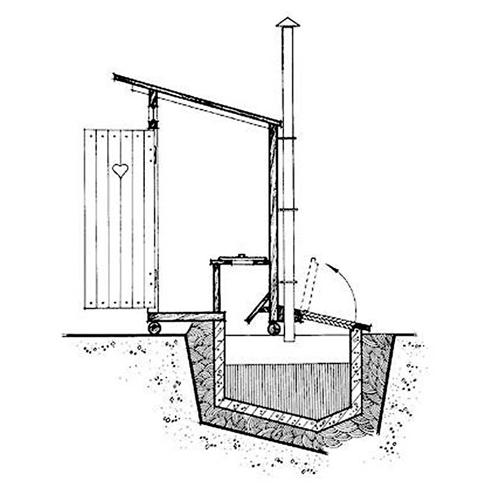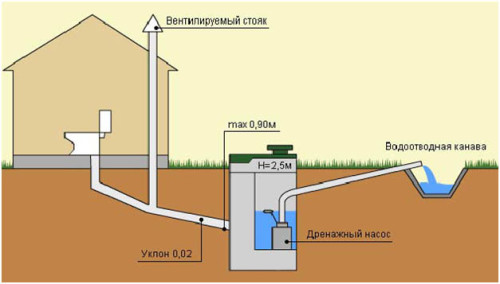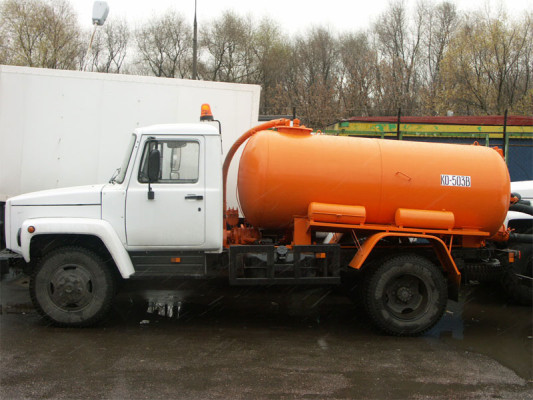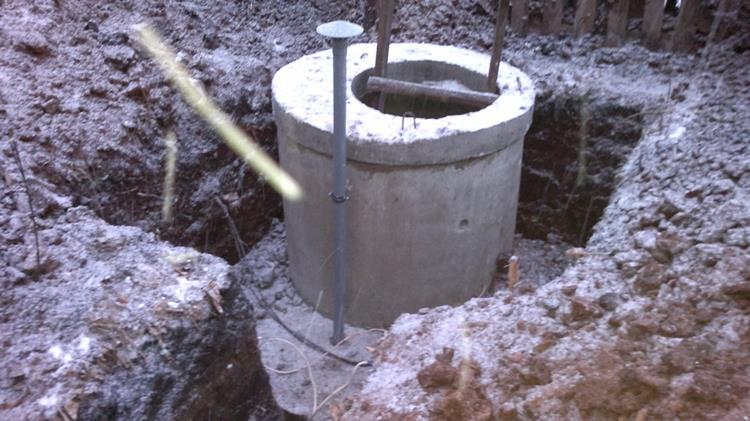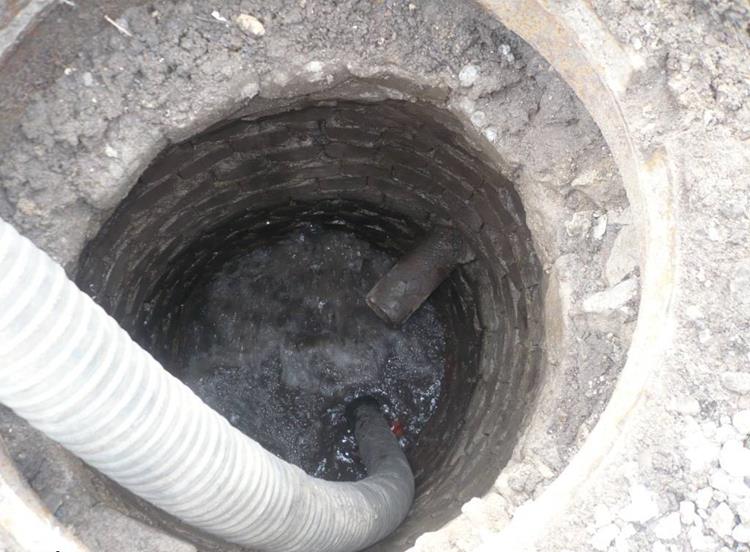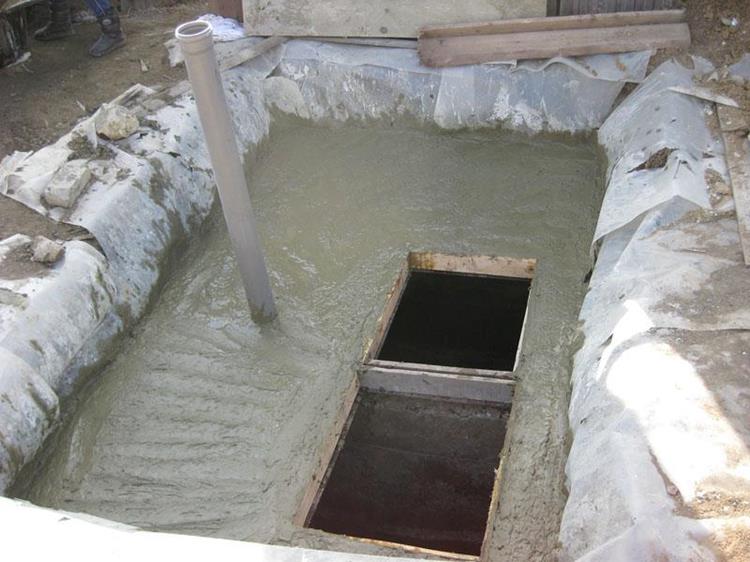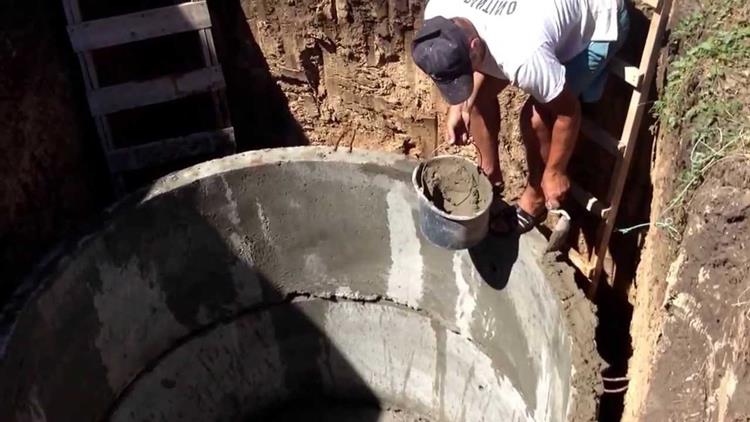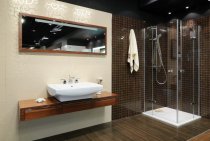Why is ventilation needed in a cesspool?
Pit ventilation prevents bad odors from entering the house and spreading to the streets. This is one of the first and important functions that it performs. It also stabilizes the pressure inside the pipes, because when they are drained, there is not enough air in them, and therefore it enters on its own through ventilation. If it does not function properly, then this air will be taken from the drain holes. And because of this, a bad smell can appear in the house.

Unpleasant smell - a signal of a malfunction of the ventilation
So that improper ventilation can disrupt the entire system and lead to irreversible consequences. Therefore, if you feel an unpleasant odor, immediately look for the cause and eliminate it.
Ventilation Device Methods
There are two types of cesspools:
Autonomous building - septic tank. If the cesspool is located on the site next to the house, the unpleasant smell from the drains will certainly spread throughout the site. How to remove the smell from the cesspool? During the construction of a sewage treatment plant in its cover, it is imperative to leave a hole for the ventilation pipe. The cross-sectional diameter of the pipe is from 10 cm. Most often, plastic pipes are used for arranging ventilation - they are light and easy to install. Insert a second pipe with a diameter of 5 cm into a pipe with a diameter of 10 cm.
The pipe is inserted into the septic tank, its lower end must be 30 cm higher than the maximum filling level of the pit. The height of the pipe must be higher than human height so that unpleasant odors go up. The upper end of the pipe must be protected from water, snow, for example, with a special cap.
Such a simple structure effectively eliminates odor. The higher the pipe, the higher the smell goes. It is not necessary to place the pit very far from the house, and the land next to the pit and above it can be used like any other: for beds or a lawn.
Cesspool under the toilet. An outdoor toilet is a frequent construction in summer cottages or in private homes. Even if there is a bathroom in the house, the owners often arrange a toilet outside in case of problems with the sewer.
Typically, an outdoor toilet is presented as a place with an unpleasant smell, located far from home. Why is there an odor? Waste accumulates in the pit under the toilet, which releases methane gas. The gas rises. This is what creates the characteristic smell. Cases of methane poisoning and fires have been reported. In addition, under the influence of methane, wood, the main material for the construction of outdoor toilets, is destroyed faster.
Today there is a way to turn the usual view. An outdoor toilet can be located close to the house and not be a source of stench. When building a toilet, it is imperative to take care of ventilation, otherwise the smell will spread both in the toilet cubicle and around it.
There are two ways to ventilate an outdoor toilet:
1. Natural. Based on the natural laws of air movement.
2. Forced. Accelerates the process of removing polluted air with a fan, so it is more efficient. The air in the cabin will be perfectly clean. But for its device, electricity is needed, it must first be brought to the booth in order to connect the fan. In addition, the organization of forced ventilation requires additional material costs - the purchase of a fan.
Both systems involve the installation of an inlet, an exhaust duct, an exhaust located above the cesspool
The easiest way to install ventilation is to install a pipe. The length of the pipe is about 3 meters, the diameter is from 11 cm. A hole needs to be made in the lid above the pit behind the toilet.
The lower end of the pipe is inserted into this hole. If there is a space between the cover and the pipe, it must be covered with sealant or filled with foam. The pipe is exposed vertically, attached to the rear wall of the toilet with clamps. A protective cap-umbrella is put on the upper end of the pipe. The pipe must be at least 70 cm above the roof of the toilet.
There are two openings in the toilet cubicle:
- Exhaust - located closer to the ceiling. It is usually cut at the top of the door. With a natural ventilation system, it also performs a second function - a window. When installing forced ventilation, an exhaust fan is installed in the exhaust hole.
- Supply - located in the lower part opposite the exhaust. To prevent mice from entering the booth, for example, a grill is installed on the air inlet.
Ventilation of a cesspool in a private house is a fairly simple matter, it does not require much time and large material costs. At the same time, ventilation effectively eliminates odors and prevents premature destruction of the toilet cubicle.
The need for a ventilation system is usually not in doubt. But not everyone understands the functions performed by this system.
Rules for the arrangement of sewerage and its ventilation
In order for the ventilation of the sewerage of a private house to work effectively, before its arrangement, it is necessary to correctly select its components in accordance with the project (drawing).
When buying pipes for sewer ventilation, it is better to focus on plastic products, its advantages:
- Ease of installation.
- Long service life.
- Less transportation costs.
For one-story private houses, the diameter of the ventilation pipes should be approximately 50 m, for higher buildings - at least 110 mm. The arrangement of ventilation must be planned in conjunction with the planning of the arrangement of the sewerage system as a whole. Lines that are too long can cause water locks that will prevent ventilation, the presence of a slope in the opposite direction from the riser can lead to air locks.
When laying sewer pipes, it is imperative to use a building level.
Inlets and sewer pipes must have a sufficient, but not too large diameter:
- 32-40 mm for bidets and washbasins.
- 50 mm for shower cabins, bathtubs, sinks.
- 100 mm for toilet bowls.
- 75 mm for risers and outlet pipes (without connection to the toilet).
The principle of operation of sewerage in a private house
Sewer system ventilation equipment
The arrangement of ventilation of the sewerage of a private house, as a rule, goes in three directions:
- Vent valves are installed.
- The riser is supplemented with a fan pipe.
- Installation of risers of the septic tank ventilation system.
When is a ventilation system required?
In order to install a good ventilation system, you need to use a fan pipe. It is she who is responsible for removing the bad smell from the pit
It is very important to install a ventilation system in those homes where the daily volume of liquid effluents is greater than that which a cesspool can handle.
If you ignore this problem, then a bad smell will occur in the house, especially if various household appliances that are connected to the sewer are constantly functioning in it. A fan pipe is installed in such cases:
- if the room has a large bath or pool;
- in multi-storey buildings, where all floors have a bath and a toilet;
- if the riser of the sewer system is not more than 5 mm in diameter.
Properly done ventilation of the cesspool will allow you to avoid the problem of unpleasant odors. But if you think you can avoid this problem without a ventilation system, then at least install valves. They will help to cope with the problem of unpleasant odor.
Septic tank ventilation
Reliable ventilation of a septic tank made of concrete rings is possible if:
- The fan pipe is located above the roof level - at least 30 cm for a flat roof, at least 50 cm for a pitched roof;
- Pipes have an inner diameter of at least 100 mm, taking into account the sewerage load;
- The ventilation of the cleaning device must not be connected to the ventilation of other rooms;
- Ventilation is made of plastic pipes, they weigh less, they are easy to mount;
- It is impossible to allow a load from the roof on the ventilation pipe, under a mass of ice, snow, the ventilation duct can be deformed and, as a result, destroyed;
- It is unacceptable to place a deflector on the head, it is capable of delaying the passage of air due to frost in winter. It is better to put a rain cap on instead;
- The supply pipe is mounted in chamber 2 to ensure the development of aerobic bacteria. It is impossible to ventilate the first chamber, anaerobic bacteria do not require fresh air;
- Covers made of concrete with an installed supply channel must be made airtight;
- The ventilation scheme must be thought out in advance.
The principle of operation of the sewer machine
The main elements of any sewage machine are: a reservoir (cistern) for transporting liquid, a vacuum pump, a pipe for pumping water from septic tanks, sewer wells, drain systems of car washes, natural reservoirs, etc. The principle of operation of such equipment is as follows:
- One end of the pipe is connected to the machine, while the other is lowered directly into the liquid container.
- With the help of a vacuum pump, water with sludge impurities is pumped into the tank. The process continues until the septic tank is completely empty or until the tank is full.
- Recycling of solid waste is carried out in strictly designated areas, taking into account environmental standards.
Theoretically, the transport tank and pumping equipment can be installed on any vehicle chassis that will meet the technical requirements. In Russia, for such purposes, as a rule, GAZ, KamAZ or ZIL are used.
Wastewater collection and disposal machine based on GAZ 3309
The maximum distance within which water can be drawn depends on the length of the pipe (sleeve). The standard length regulated by the manufacturer usually varies between 6-15 m. On an individual order, this parameter can be increased to 25 m. Some vacuum trucks use additional sleeves that allow you to increase the length by another 5-10 m. However, even this is sometimes not enough to clean a septic tank located at a great distance from the roadway. In this case, the owners of the site will require additional measures.
Purpose of ventilation
It is widely believed that ventilation outlets in an autonomous sewer serve only to prevent an unpleasant odor from entering the house and living quarters.
This function is really available and is an important component. However, there is another important role of ventilation for sewers.
It balances the pressure inside the pipeline.
When drains are drained, a vacuum and air deficiency are formed in the pipeline. Then it starts going there automatically. If the ventilation is not working properly, air will not flow into the ventilation outlets, but through the drain holes.
Such operation of the pipeline can cause a disruption of the entire system. Therefore, the air must come from the ventilation outlets. The holes should be on the highest parts of the risers, the ends of which go to the roof.
But in an autonomous sewer system, stench elimination is also a very important function. This is especially necessary in the case of special cleaning septic tanks or autonomous stations, as well as in storage tanks.
About what should be the ventilation of the cesspool in a private house, let's talk in more detail.
When organic matter decomposes, not only an unpleasant odor is formed, but also a combustible gas, methane.With its large accumulation, if special ventilation ducts are not provided, poisoning and even a fire may occur.
Ventilation inside the house
Ventilation ducts must be installed inside the country house. Usually, a place for them is chosen at the upper end of the sewer riser.
Ventilation equipment for sewerage at the stage of laying the foundation of a private house
To ensure sufficient ventilation, the risers must exit above roof level. It is not even necessary that this pipe be vertical. It can also be bent. This outlet must not be connected to a chimney.
When bringing the pipe to the roof, the following rules must be observed:
- the upper end is carried out from the roof at least seventy centimeters;
- from the end of the branch to the nearest window must be at least four meters;
- the internal sections of the sewer risers and ventilation outlets must be the same.
Thanks to the device, when a vacuum forms in the sewer, air will be collected from the atmosphere. And the rest of the time it will be closed. The valve can be installed on any section of the sewer riser. However, it should be above all plumbing fixtures at home.
If necessary, the valve is even made by hand. For this:
- a spring is taken out of an ordinary handle, a self-tapping screw is selected under it, the length of which should be four and a half centimeters;
- a washer is made of plastic with a cross section of five centimeters from the outside;
- another puck is made of foam rubber with a cross section of six centimeters;
- holes are drilled on the lid for air flow;
- all components of the structure are assembled on the end cap so that the self-tapping screw is screwed in from the inside.
The device can be mounted on a tee by installing it on the highest section of the sewerage system. Then, when a vacuum occurs, the pressure from the outside will compress the spring and move the plastic-foam valve away.
Cesspools and their types
Central sewerage is, of course, the best of the systems that can be in a country house. However, for private country houses - this is far from always available. Therefore, you have to solve this issue yourself. A frequent solution is still the arrangement of a cesspool. To improve the quality of living, it is necessary to properly equip it.
Reservoirs for this are constructed in different ways. For example, use old tires. By type, cesspools are divided into:
- absorbent;
- sealed;
- septic tanks.
Whatever type is used, the pit is dug to a depth of no more than three meters, otherwise there is a risk of contamination of groundwater, which negatively affects the ecology of the site and the territory beyond it.
What are the cesspools
Cesspools are designed to collect a wide variety of liquid effluents. To make such a structure is not at all difficult. You can use rings poured from concrete, old tires and any other material. There are several types of cesspools:
- absorbing type;
- sealed type;
- septic tank.
It does not matter which of the cesspools you will use, but you should know that its depth should not be more than three meters. Otherwise, there is a risk of contamination of groundwater, and this has a bad effect on the environment.
The cesspool should not be close to the house.
During its construction, it is necessary to choose the right volume of the tank. Then you can avoid overfilling and unpleasant odors.
It is necessary to periodically clean the cesspool with the help of special antiseptics. There are even products that destroy detergents, paper and other nitrates. After treatment with such a preparation, the bad smell will disappear, and the liquid in the pit will decrease. If you constantly perform such actions, then you will not have to pump out the liquid soon.
Do-it-yourself ventilation of the cesspool
Not everyone has the opportunity to hire people who will make ventilation for the cesspool.Therefore, everyone can do it on their own. Ventilation of the cesspool is necessary, but the process of creating such an air duct is not an easy task. First you need to calculate the diameter of the pipe that will be used for ventilation. After that, you can safely get to work.
How to make ventilation of the pit with your own hands? This does not require any effort. If you want to use the natural type of ventilation, then you do not need to have any special knowledge at all. In the inspection hatch, make a hole into which the fan pipe will be inserted. Remember, the higher the pipe is located, the better the air exchange will be. For ventilation of this type, you will need tools such as a knife, grinder, puncher, level and tape measure.
First you need to measure the distance from the extreme protrusion of the pit to the exhaust duct.
Then we make a markup in order to drill a hole for the pipe. In order to fix it, you need to use a plastic sleeve. Treat the joint with sealant so that excess air does not enter the cesspool. A mesh is installed at the inlet of the pipe, which will protect it from contamination.
After all the steps taken, you need to supply electricity to the ventilation system. This is necessary for the fan to work. By the way, it is attached with self-tapping screws. Upon completion of all internal work, an air outlet is connected to the ground part of the pipe. From above, the pipe must be closed with a special cap that will protect the ventilation passage from precipitation and various debris.
It is important to make the hood in the cesspool in such a way that no outside air enters it. To do this, you need to firmly close the hole
Often in winter, moisture can accumulate on the outlet pipe, which affects the intensity of the air flow. Therefore, in order to avoid such a problem, a deflector is installed. This device allows not only to improve the air flow, but also to protect the pipe from various debris.
It is best to make ventilation for the cesspool when installing the sewer system. So you can install your ventilation duct anywhere. It is also worth remembering that not in all cases it is worth using a forced type of ventilation. Natural ventilation will suffice. If you are not sure about the type of ventilation, then consult a specialist before starting work. He will be able to answer any question that interests you.
Location Features
The pit should not be placed too close to the house
So that the unpleasant smell does not bother the inhabitants of the house, it is necessary to pay attention to the fit of the collection hatch. Outdoor toilet must be attached without gaps
Ventilation in a pit latrine can be arranged by installing a regular PVC sewer pipe, ten centimeters in diameter. It is attached to the wall at the back. A hole is drilled on the floor for the pipe and lowered by about ten centimeters. The upper end extends beyond the roof by more than twenty centimeters. From below, the pipe must be insulated with tow moistened in advance with a bitumen primer. The exit is covered with a tin sheet, treated with foam or cemented.
When ventilation is installed in a cesspool without a toilet, installation is carried out in the same way. A pipe is inserted not far from the hatch, the length of which is calculated depending on the height of the outlet. If you attach an exhaust motor to the upper end, then the stench will not spread to the site, even in the summer heat.
By constructing a ventilation system in this way, it will be possible to avoid the accumulation of harmful gases and, as a result, the occurrence of an unpleasant odor in the toilet itself.
In addition, ventilation of the cesspool will prevent the harmful effects of fumes from feces on the wooden structure. Thanks to this, the term of the country toilet will increase markedly.
When building a pit latrine, it is best to make sure that the pit latrine is separate from the pit latrine. It is not difficult to connect them using a conventional sewer pipe with a large cross section. In this case, a branch for ventilation is connected to the pipe itself through a tee. Then excellent ventilation will be guaranteed, but on condition that a drain system is additionally provided for the toilet.
One way or another, the ventilation system here can be built in two ways:
- natural ventilation involves ventilation through increased pressure in the pit;
- with forced ventilation, air exchange will be carried out through fans that are powered by electricity.
Installation of natural ventilation
Above, we briefly mentioned the installation of natural ventilation of the toilet. Let's consider this process in more detail.
The air from the cesspool will be vented to the atmosphere through a vertical vent pipe installed on the back wall of the toilet. The outlet end at the top must extend beyond the roof.
Air will move due to the difference in pressure in the toilet and the atmosphere. Then the smell will not get into the room itself and the gases will be effectively removed to the outside.
The entrance of the sewer pipe must not be lower than the level of filling with sewage. Then it will never be closed by waste products.
To ensure sufficient air movement, the outlet section is made more than ten centimeters, and the upper end is raised more than seventy centimeters above the roof.
For a tighter fixation of the pipe to the toilet wall at the back, plastic clamps are sometimes used. Then you can be calm for her even during a strong wind.
In addition, the junction of the inlet pipe of the ventilation pipe and the cesspool must be carefully sealed.
Forced ventilation installation
The most effective method of ventilation is forced. It can only be implemented if there is an electrical supply on the site. But when used, you don’t have to worry: all gases from organic decay will be completely removed. The device is mounted as follows:
- Even when the toilet is being built, you need to think about the location of the ventilation system and build a window for ventilation. It will be a source of illumination on the one hand, and an opening for air flow, on the other.
- The toilet is supplied with electricity. A suspended structure for this will be the easiest way. When laying the power line, a cable is used that has special protection against external influences.
- The fan is selected. In order for the air circulation here to occur normally, a model with a power of up to 300 watts will be sufficient.
- It is best to first select a fan, and only then form the necessary hole under it. It only moves air in one direction. Usually this is air distillation to the outside.
- To prevent vacuum from forming in the toilet, holes must be provided for air to enter. Their role may well be played by a gap located between the end of the door from below and the threshold.
